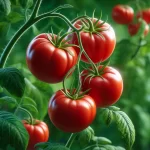Tomato (Solanum lycopersicum) is a horticultural crop of great global relevance, appreciated for its nutritional value and culinary versatility. For producers in Latin America, achieving successful and high-quality tomato production requires a deep understanding of its phenological stages and the implementation of precise agronomic management strategies adapted to each phase of its development. This article delves into each stage of the tomato life cycle, offering advanced technical advice to maximize yield and harvest quality.
Breaking Down the Phenological Stages of Tomato for Optimal Harvest
Stage 1: Germination and Seedling Development – Sowing Success from the Start
The germination of the tomato seed is the starting point of the crop cycle. This process begins with water absorption, activating the enzymes that allow the embryo to develop. For uniform and vigorous germination, it is crucial to use high-quality seeds and provide optimal conditions of humidity (well-drained and consistently moist soil), temperature (between 20-25°C), and aeration in the sowing substrate (which can be peat moss, coconut fiber, or commercial mixtures).
Seedling development in the nursery is a delicate phase that requires meticulous care. Seedlings need adequate light (natural or artificial) for strong growth and to prevent etiolation. The temperature should be kept constant, and watering should be controlled to avoid excessive moisture that favors fungal diseases such as damping-off. Nutrition at this early stage should be light and balanced, with an emphasis on phosphorus to promote good root development. Transplanting to the field or greenhouse should be done after the last frosts have passed and the seedlings have a well-established root system and at least 3-4 true leaves.
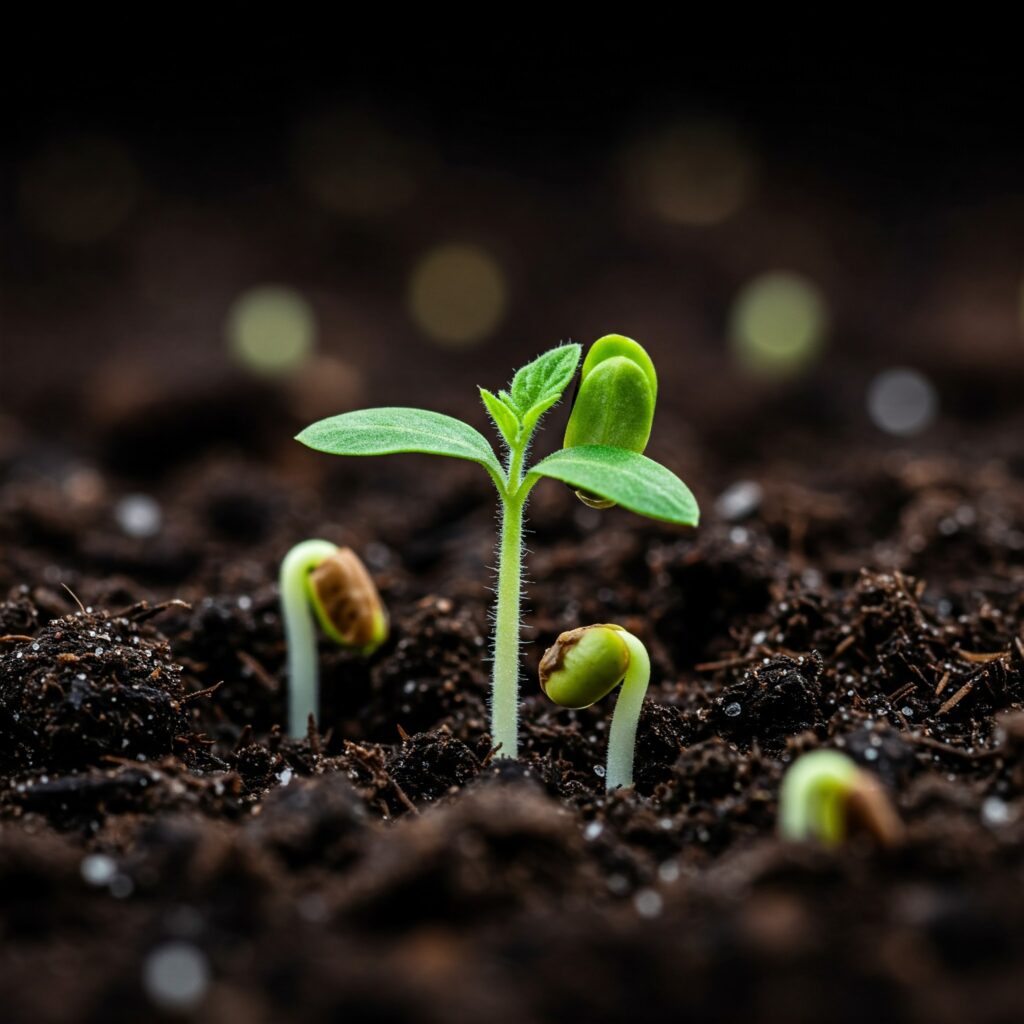
Stage 2: Vegetative Growth – Building a Solid Foundation for Production
The vegetative growth stage extends from transplanting to the appearance of the first flower buds. During this phase, the tomato plant focuses its energy on developing a robust root system, strong stems, and abundant foliage, which are essential to support the future fruit load. Adequate and regular irrigation is crucial, adjusting the frequency and amount according to climatic conditions and plant size. Nutrition should be balanced, with an adequate supply of nitrogen for vegetative growth, phosphorus for root development, and potassium for overall plant strength.
Management practices such as staking (with stakes, trellises, or cages) and pruning (removal of lateral shoots or “suckers” in indeterminate varieties) are fundamental at this stage. Staking provides support to the plant as it grows and bears fruit, improving air circulation, light penetration, and facilitating harvesting. Pruning directs the plant’s energy towards the development of the main stems and fruit production. Weed control, which competes for resources, and monitoring for early pests (such as aphids and whiteflies) and foliar diseases (such as early blight) are important to ensure optimal vegetative growth.
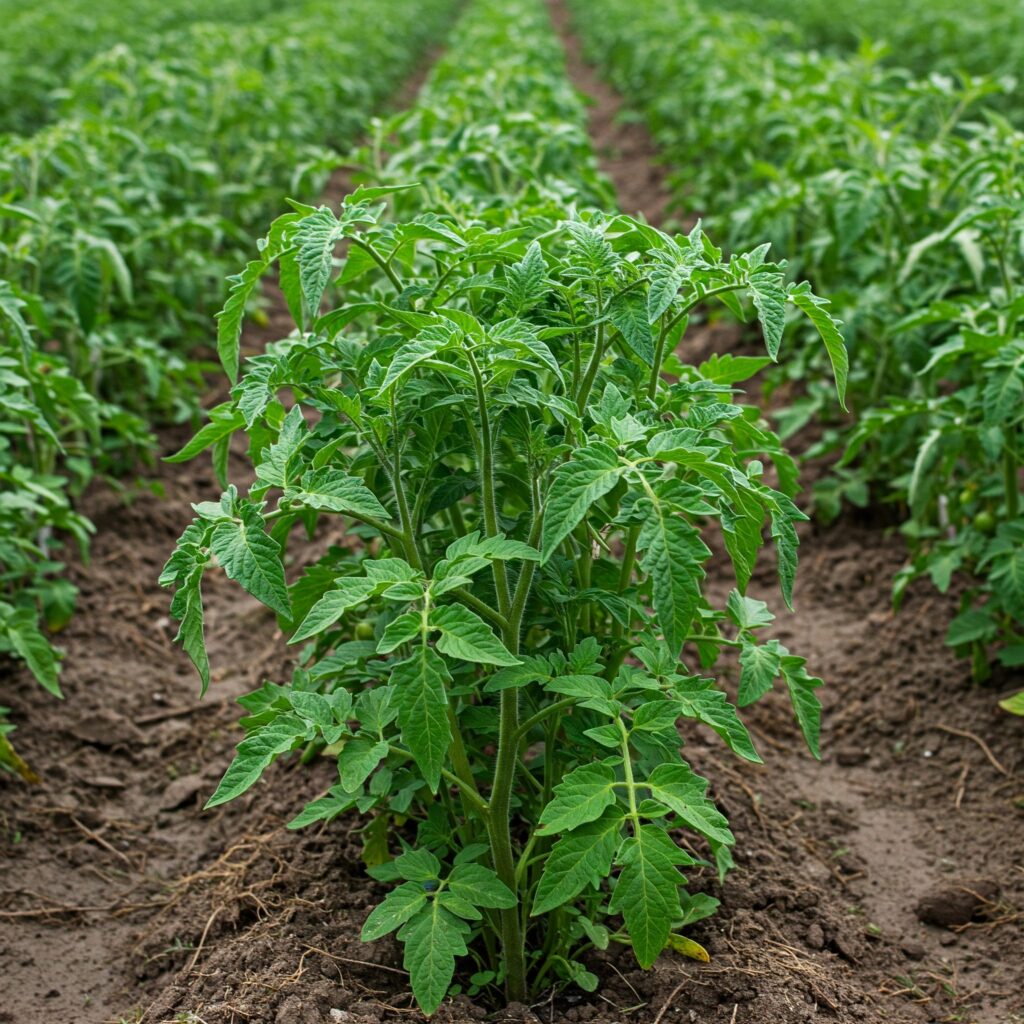
Stage 3: Flowering – The Beginning of the Fruit Promise
Flowering marks the transition from the vegetative to the reproductive stage. Flower buds develop in clusters along the stems. Pollination is a crucial process for fruit formation. In tomatoes, pollination is mainly self-pollination, facilitated by the vibration of the flowers, which can occur naturally by wind or insects, or be artificially assisted in greenhouses (with mechanical vibrators or the introduction of bumblebees).
Management during flowering focuses on ensuring optimal environmental conditions for pollination and fruit set. Extreme temperatures (above 32°C or below 15°C) and inadequate relative humidity can negatively affect pollen viability and stigma receptivity, reducing fruit set. Consistent and adequate irrigation is essential to avoid water stress that could cause flower drop. Nutrition, especially the supply of phosphorus and boron, plays an important role in floral development and fruit set. Foliar application of boron can be beneficial in some cases.
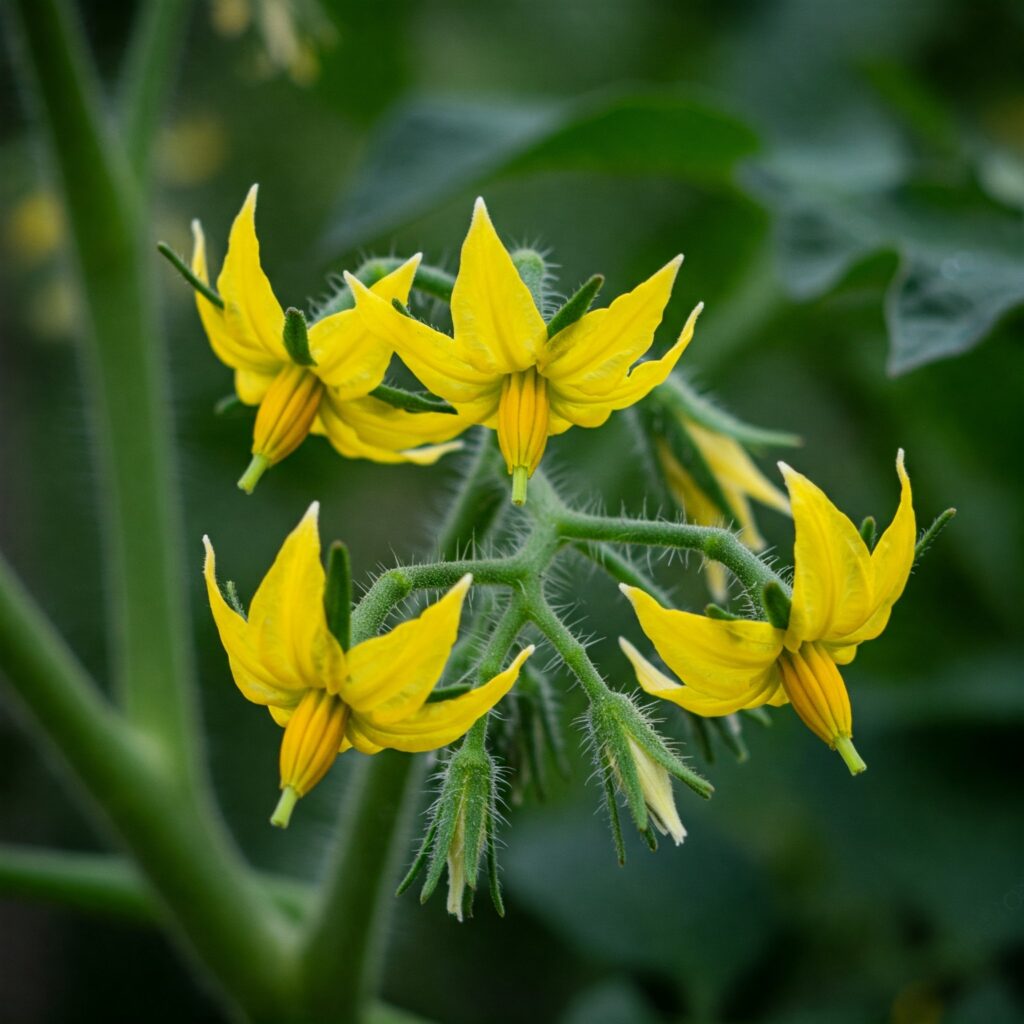
Stage 4: Fruit Development – Growth and Maturation of the Precious Tomatoes
After successful pollination and fruit set, the small fruits begin to develop. This stage of fruiting is characterized by rapid fruit growth, accumulating water, sugars, and other compounds that determine their final size, weight, and quality. The demand for water and nutrients by the plant is high during this phase. Regular and consistent irrigation is crucial to avoid problems such as fruit cracking and ensure uniform development. Nutrition, especially the supply of potassium and calcium, is fundamental for fruit filling and firmness, as well as for preventing disorders such as blossom-end rot caused by calcium deficiency.
Management during fruiting includes monitoring and controlling pests that attack the fruits (such as whiteflies, fruitworms, and tomato moths) and diseases (such as late blight and powdery mildew). Thinning fruits in clusters with excessive load can improve the size and quality of the remaining fruits. Staking is essential to support the weight of the developing fruits and prevent them from coming into contact with the soil, which increases the risk of diseases and damage.
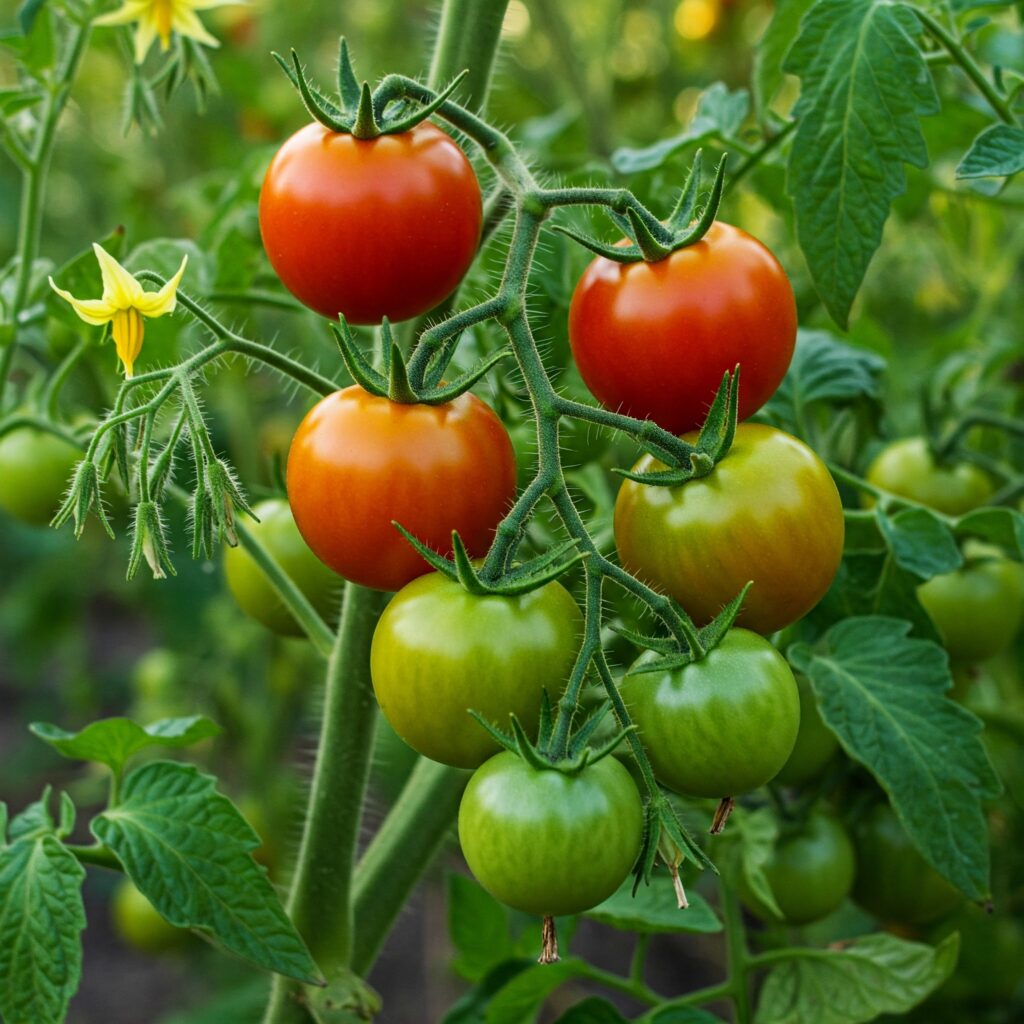
Stage 5: Maturation and Harvest – The Culmination of Effort
Maturation is the final stage of fruit development, where tomatoes change color (from green to yellow, orange, or red, depending on the variety) and reach their optimal point of flavor, aroma, and texture. Harvesting should be done at the desired stage of maturity, which varies depending on the market and final use (fresh consumption, processing). For the fresh market, tomatoes can be harvested at the mature-green stage (when they have reached their final size but are still firm and beginning to change color) or at full ripeness.
Harvesting should be done carefully to avoid mechanical damage to the fruits. The frequency of harvest will depend on the rate of maturation, which is influenced by temperature and variety. In staggered or continuous crops, harvesting is done several times a week. Proper post-harvest handling, which includes cleaning, grading by size and quality, packaging, and temperature and humidity control during storage and transport, is essential to preserve quality and extend the shelf life of the tomatoes.
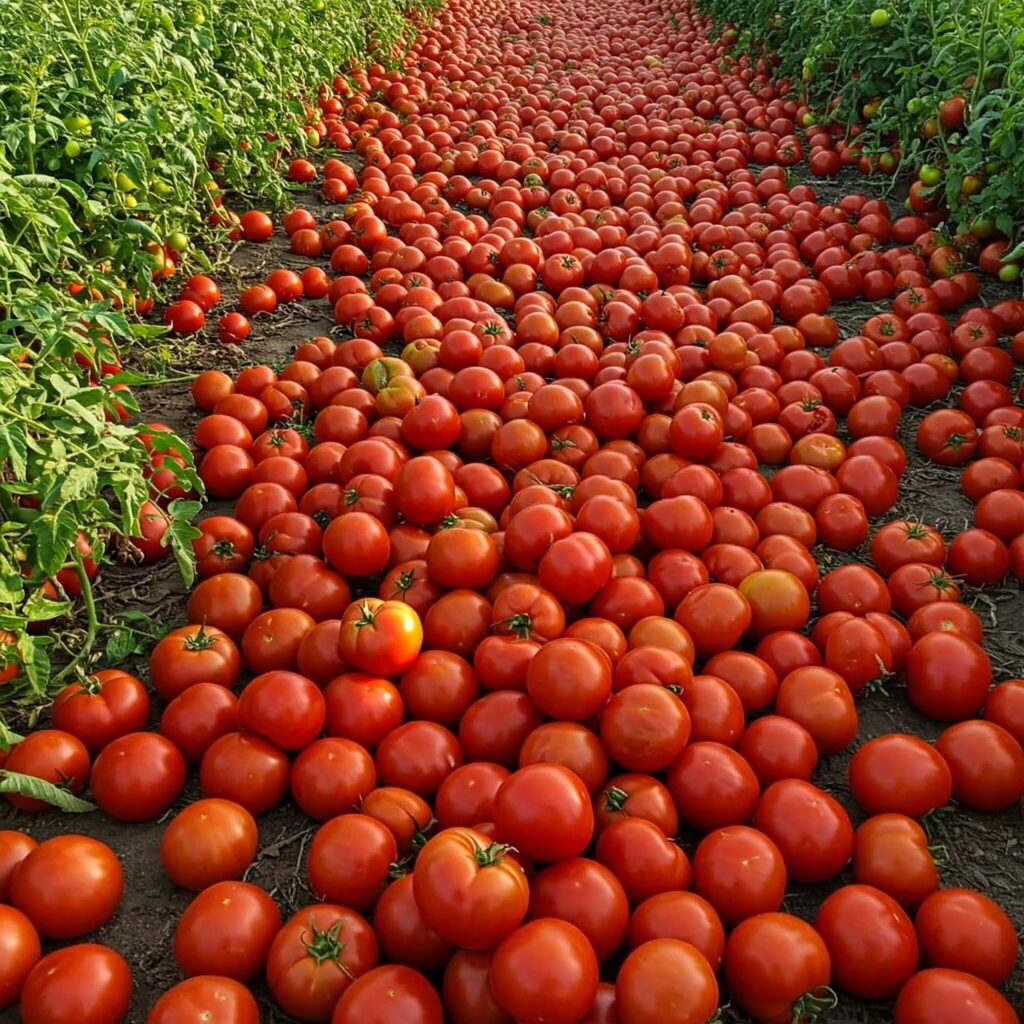
Advanced Strategies to Maximize Tomato Harvest
To achieve abundant and high-quality tomato harvests, producers can implement advanced agronomic strategies at each phenological stage:
- Selection of High-Yield and Quality Varieties: Choose hybrid or improved varieties with high yield potential, good fruit quality, disease resistance, and adaptation to local agro-climatic conditions.
- Soil Management and Precision Nutrition: Conduct periodic soil analyses to determine the specific nutritional needs of the crop and apply fertilizers in a balanced and efficient manner, using techniques such as fertigation and foliar application of micronutrients.
- Integrated Pest and Disease Management (IPM): Implement strategies that combine biological control (use of natural enemies), cultural control (crop rotation, residue removal), genetic control (use of resistant varieties), and chemical control (selective application of pesticides) to minimize the impact of pests and diseases.
- Irrigation Optimization: Use efficient irrigation systems such as drip irrigation, scheduling irrigation based on crop evapotranspiration and soil moisture to ensure optimal water supply and avoid water stress.
- Protected Cultivation Techniques (Greenhouses and Macro-tunnels): Use protected cultivation structures to control environmental conditions (temperature, humidity, light), extend the production season, and improve quality and yield.
- Assisted Pollination: In covered crops or under unfavorable environmental conditions, use mechanical vibrators or introduce bumblebee colonies to ensure efficient pollination and good fruit set.
- Flower and Fruit Thinning: Perform selective thinning of flowers or fruits to regulate the plant load, improve the size and quality of the remaining fruits, and prevent plant exhaustion.
- Use of Biostimulants: Apply biostimulants based on seaweed extracts, amino acids, or beneficial microorganisms to improve plant growth, nutrient absorption, and resistance to abiotic stress.
- Monitoring and Detailed Records: Keep accurate records of environmental conditions, management practices, crop phenology, and the incidence of pests and diseases to make informed decisions and adjust management strategies.
Conclusion: A Strategic Approach for a Successful Tomato Harvest
Understanding and managing the phenological stages of tomato with precision and implementing advanced agronomic strategies are fundamental to achieving abundant and high-quality harvests. By adopting a comprehensive approach that considers the specific needs of the plant at each phase of its development, tomato producers in Latin America can optimize their production systems, improve the efficiency of resource use, and meet the growing market demand for this important crop.
References:
- Jones, J. B., Jones Jr., J. P., & Stall, R. E. (2013). Compendium of Tomato Diseases and Pests. American Phytopathological Society.
- FAO (Food and Agriculture Organization of the United Nations). (2001). Tomato production under plastic.
- [Include other references of specific agronomic and physiological studies on the phenological stages of tomato].
- [Cite manuals of good agricultural practices for tomato cultivation from research or agricultural extension institutions].
Keywords: Tomato, phenological stages, germination, vegetative growth, flowering, fruiting, maturation, harvest, agronomic management, pruning, staking, pollination, nutrition, irrigation, pests, diseases, tomato quality, yield.
 AgronoBlog – Agriculture Blog
AgronoBlog – Agriculture Blog 


